This article was published in Scientific American’s former blog network and reflects the views of the author, not necessarily those of Scientific American
I’ve said before that there are entire tetrapod groups that I’ve only ever mentioned in passing, or in cases not even mentioned at all. Today we’re going to look at one of those groups… though, as it turns out, it might not really be ‘a group’ at all. I’m talking about the microsaurs, an extinct Paleozoic group, conventionally put somewhere within that gargantuan assemblage of lineages termed ‘amphibians’. Because that term is so typically associated with extant lissamphibians – this meaning that ‘extinct amphibians’ are then assumed to be lissamphibian-like as goes morphology and biology, or closely related or ancestral to extant lissamphibians – it has been argued that a less loaded term be preferred. For that reason I use ‘anamniote’ (= synonymous with ‘non-amniote tetrapod’) for these animals. But I digress, and even this term might not be ok for microsaurs, as we’ll see.

That goddam book again - will it ever be finished? Credit: Darren Naish
The text you’re about to read is a substantially reduced section from the giant anamniote chapter of my in-prep textbook, The Vertebrate Fossil Record, currently over 1000 pages long and still incomplete. You can read more about the project and see how things are going by supporting me here.
On supporting science journalism
If you're enjoying this article, consider supporting our award-winning journalism by subscribing. By purchasing a subscription you are helping to ensure the future of impactful stories about the discoveries and ideas shaping our world today.
Microsaurs – or ‘microsaurs’ (read on) – are a large Carboniferous and Permian anamniote group that thrived at high diversity at some of the (mostly North American and European) localities that yield them, four to six species being contemporary at various sites. Until recently, the oldest microsaur was Utaherpeton from the Chesterian/Morrowan of Utah; Kirktonecta from East Kirkton, Scotland, has since extended the history of the group back to the Viséan (Clack 2011).
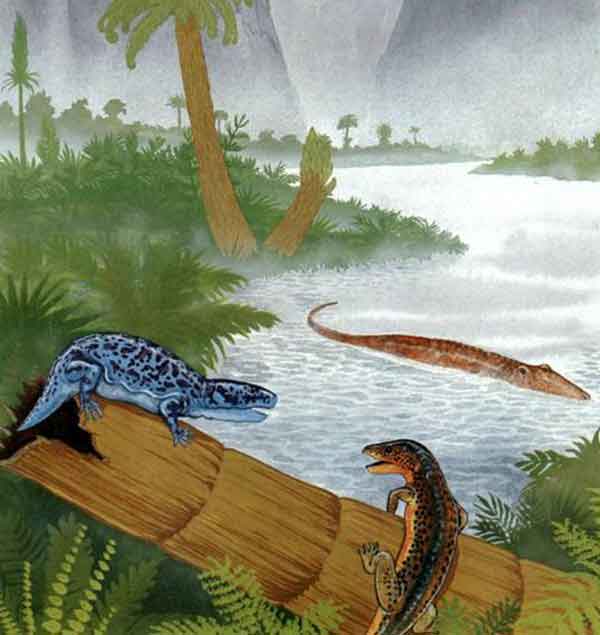
Part of a scene depicting Carboniferous life in Nova Scotia, from a larger illustration by Graham Rosewarne and featured in Michael Benton's 1990 Reign of the Reptiles. In the foreground we see two microsaurs: they might be based on Pantylus (at left) and Archerpeton but I'm not sure. The big animal in the water is a temnospondyl (it's meant to be Dendrerpeton but is, incorrectly, modelled instead on a capitosauroid). Credit: Benton 1990
Lizard-like, salamander-like and long-bodied swimming or burrowing microsaurs are known, virtually all being less than c 30 cm in total length. In fact a microsaur 30 cm long would be large; at the other extreme, others were adult at less than 12 cm. Microsaur means ‘small reptile’ and the similarity that microsaurs have with reptiles initially – that is, between approximately the 1860s and 1950s – resulted in their classification within Reptilia. Not until the 1950s did the concept emerge of a Microsauria nothing directly to do with reptiles. Microsaurs of several groups resemble temnospondyls in the form of their occipital joint, typically have only one bone is the position occupied by the tabular (early amniotes have two bones here, a tabular and a supratemporal), and possess four fingers rather than five (Clack 2002). Some aquatic microsaurs only possess three fingers and the possible absence of hindlimbs has even been implied for one group (Odonterpetontidae or Odonterpetidae). It remains true, however, that some microsaurs look surprisingly reptile-like in skull form and overall morphology… read on. There are no clear indications that these animals underwent metamorphosis, and indeed the pelvic girdles and limbs of at least some taxa (only a few provide the sufficient data) ossified early in development (Olori 2015).
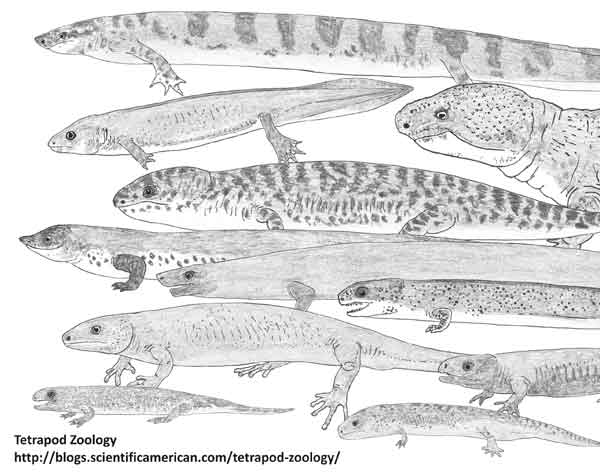
An in-prep microsaur montage from the relevant section of my in-prep The Vertebrate Fossil Record. Most (but not all) microsaur lineages are represented here. Credit: Darren Naish
Microsaur skulls are typically narrow or triangular in dorsal view and of a generic ‘salamander-like’ form, with pointed, slightly recurved tooth crowns. Postorbital openings like otic notches are absent. Several microsaur groups (those united within the clade Recumbirostra) exhibit adaptations for head-first burrowing and are among the oldest tetrapods specialised for this lifestyle. Bicuspid teeth are present in some taxa (Anderson & Reisz 2003), an enlarged first maxillary tooth is present in the pantylid Pantylus (and in other taxa too) and tricuspid teeth are present in the broad-snouted brachystelechid Batropetes. Numerous small denticles typically cover the palate, sometimes accompanied by a few larger teeth. Microsaur skull and tooth form suggests insectivory and animalivory, with some of the larger, stouter-toothed taxa perhaps eating molluscs and smaller vertebrates.

A montage of microsaur skulls, to scale. Note the variation in size, the various dentitions and the ‘overhanging’ snouts of some taxa (typical of recumbirostrans). Credit: Schultze & Foreman 1981
Long-bodied microsaurs like Microbrachis possess more than 40 vertebrae, compared to the 15-26 present in most others. A deep tail fin was present in at least some aquatic taxa, including Microbrachis and Kirktonecta (Clack 2011). Large numbers of thin, overlapping scales are typically preserved; they were dermal bones and hence would have been embedded within the dermis. Microsaur scales frequently have thickened posterior margins and possess striations or starburst or net-like ornament. Microsaurs are typically illustrated with blunt tips to their digits and no claws; weird, squared-off terminal unguals are present on most digits of Tuditanus (Carroll & Baird 1968). It is quite common, however, for microsaur unguals to be pointed and be of a form that might be expected to support a keratinous claw. Claws have been excluded from the reconstructions included here.

Tuditanus punctulatus, as reconstructed by Carroll & Baird (1968). You will note a somewhat reptile-like demeanour. Credit: Carroll & Baird 1968
The differences between the many microsaur groups show that these animals differed substantially in shape and hence presumably in ecology and lifestyle. While some tuditanids were built something like robust terrestrial lizards, the long-bodied microbrachids were certainly aquatic (they have lateral line canals and gill-arch denticles), and ostodolepids were terrestrial burrow-dwellers. As noted above, superficially caecilian-like adaptations for head-first burrowing are present in recumbirostrans. Indeed, some experts have argued that microsaurs include the ancestors of caecilians, with brachystelechids regarded as the caecilian sister-group by Anderson (2001). Like caecilians, brachystelechids have several tooth cusps. However, caecilian cusps are arranged labiolingually while those of brachystelechids are aligned anteroposteriorly.
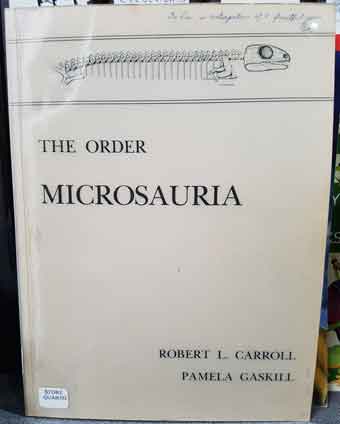
My own, cherished copy of Carroll & Gaskill (1978). And look up at the top right corner... Credit: Darren Naish
Of Tuditanomorpha, Microbrachomorpha and Recumbirostra. The standard work on these animals is Carroll & Gaskill’s (1978) The Order Microsauria, an impressive monograph sometimes affectionately termed Carroll’s “big book of microsaurs” (Anderson & Reisz 2003). Carroll & Gaskill (1978) argued that Microsauria consisted of two groups: the mostly terrestrial Tuditanomorpha and the mostly aquatic Microbrachomorpha. Tuditanomorpha (beware the spelling ‘Tuditanimorpha’ used in some papers) as conceived by these authors is the larger group, thought to contain seven families. It has been suggested that this group reveals an evolutionary trend whereby short-bodied, salamander-like forms gave rise to ever longer-bodied descendants, increasingly specialised for a burrowing lifestyle (Milner 1993).
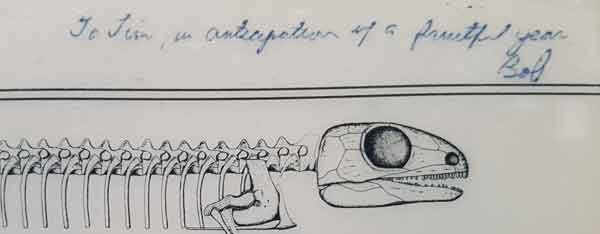
Yes, it's signed, by one of the authors at least. I wonder who the ‘Jim’ is? Credit: Darren Naish
How have these two groups withstood recent phylogenetic studies? It’s fair to say that microsaur phylogeny “is a mess” (Marjanović & Laurin 2016): numerous different topologies have been proposed and neither Tuditanomorpha nor Microbrachomorpha have remained monophyletic across all studies. Anderson (2007) proposed the name Recumbirostra for a set of taxa where the skull is torpedo- or bullet-shaped, the snout is bent downwards and shovel-shaped, and the skull roof is reinforced and stegokrotaphic (meaning that it is roofed dorsally and lacks openings). Recumbirostran monophyly appears reasonably stable in recent studies, but some taxa specifically excluded from the group when it was defined insist on falling within it in some studies (Marjanović & Laurin 2016).
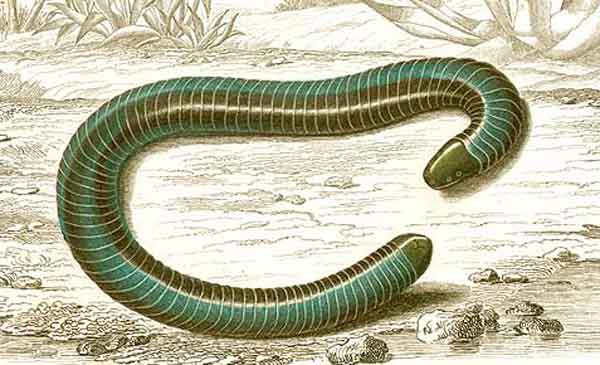
I’m sure you already know what caecilians are. They’re among the most amazing animals on the planet, that’s what. This illustration of the South American Siphonops comes from Charles d’Orbigny’s work of 1849. Credit: Wikimedia
Are caecilians recumbirostrans? Some members of Recumbirostra look somewhat caecilian-like and have hence been considered caecilian ancestors, as we’ve seen. However, the specific features involved – like a reinforced, heavily ossified anterior braincase – have proved anatomically distinct in detail and not as similar as initially proposed (Maddin et al. 2011, Pardo et al. 2015). Furthermore, the idea that the recumbirostrans in question are especially caecilian-like assumes that a specific subset of taxa – perhaps even a single species – possesses the caecilian-like features in question. But alas, these features are present in distinct recumbirostran taxa scattered across the tree; no one member of the group possesses all the caecilian-like features combined (Szostakiwkyj et al. 2015), this indicating that the caecilian-like features have been convergently evolved within Recumbirostra on a number of different occasions. As you might know, caecilian ancestry has recently been linked with another anamniote group, on which more later.
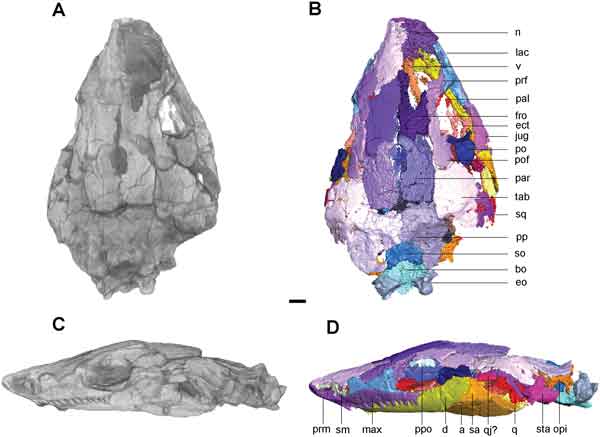
Skull of the recumbirostran Aletrimyti gaskillae in (A-B) dorsal and (C-D) left lateral views, C and D showing the skull after it was submitted to high-resolution CT scanning. There are several specialisations here for head-first burrowing. Credit: Szostakiwkyj et al. 2015 (CC BY 4.0)
How microsaurs are related to other tetrapods more broadly is controversial and there are several competing hypotheses. A popular idea is that they belong within Lepospondyli together with nectrideans and aïstopods. However, several studies that support a lepospondyl position have not recovered microsaur monophyly (Laurin 1998, Ruta et al. 2003, Ruta & Coates 2007). I’ll say in passing here that lepospondyl monophyly is itself in massive doubt, but that’s an issue for another time.
The big surprise, however, comes from Pardo et al.’s (2017) new study of cranial anatomy in early tetrapods. Their study focused on high-resolution CT data from the weird, limbless aïstopods: they show how these animals are more archaic in palatal and braincase structure than previously thought, the result being that they’re recovered in a surprising, early-diverging position within Tetrapoda. Consequently, several characters that previously helped ‘tie’ microsaurs to other ‘lepospondyls’ now have a different distribution, a knock-on effect being that the majority of microsaurs (recumbirostrans in particular) now nest elsewhere… and that ‘elsewhere’ is within amniotes, and specifically within reptiles (Pardo et al. 2017), a surprising conclusion that was nevertheless presaged in previous studies that pointed to the strong similarities shared by certain microsaurs and captorhinid reptiles but dismissed them as convergence (Reisz et al. 2015). Note that this study did not include data from microbrachids.
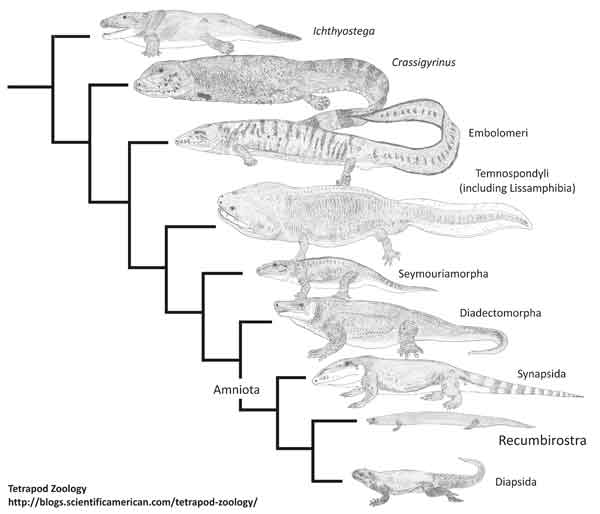
Substantially simplified cladogram based on the topology recovered by Pardo et al. (2017): recumbirostran microsaurs are amniotes, and reptiles! One of numerous cladograms from my in-prep textbook. Credit: Darren Naish
So, most (but not all) microsaurs are now reptiles again.... for now. We’ll see over coming months and years how this proposal stands up to additional testing, but it’s by no means ridiculous given the robust, amniote-like skulls and strong terrestriality present in some microsaur lineages. Of course, a reptile position for the microsaurs concerned also means that their biology and anatomy should now be imagined as ‘reptile-like’ rather than ‘amphibian-like’, if this new phylogenetic model is valid.
There is, as always, tons more to say about these animals – the microsaur section in my book runs to seven pages – but I hope this provides a useful introduction. For previous Tet Zoo articles on archaic anamniotes, see…
Crassigyrinus, or… How I’d love a giant killer Carboniferous tadpole for a pet
Further temnospondyl adventures: it’s mostly about the dissorophoids (or some of them anyway)
Trematosauroids, those gharial-snouted, marine temnospondyls
Trimerorhachid temnospondyls: numerous scale layers and… gill-pouch brooding?
More temnospondyls: gigantic, gharial-snouted archegosauroids and their spatulate-snouted kin
The troubling lack of Platyhystrix images online: the Tet Zoo Solution
Refs - -
Anderson, J. S. 2001. The phylogenetic trunk: maximal inclusion of taxa, with missing data in an analysis of the Lepospondyli (Vertebrata, Tetrapoda). Systematic Biology 50, 170-193.
Anderson, J. S. 2007. Incorporating ontogeny into the matrix: a phylogenetic evaluation of developmental evidence for the origin of modern amphibians. In Anderson J. S. & Sues, H.-D., eds. Major Transitions in Vertebrate Evolution. IndianaUniversity Press, Indiana, pp. 182-227.
Anderson, J. S. & Reisz, R. R. 2003. A new microsaur (Tetrapoda: Lepospondyli) from the Lower Permian of Richards Spur (Fort Sill), Oklahoma. Canadian Journal of Earth Sciences 40, 499-505.
Benton, M. J. 1990. The Reign of the Reptiles. Kingfisher Books, London.
Carroll, R. L. & Baird, D. 1968. The Carboniferous amphibian Tuditanus [Eosauravus] and the distinction between microsaurs and reptiles. American Museum Novitates 2337, 1-50.
Carroll, R. L. & Gaskill, P. 1978. The Order Microsauria. American Philosophical Society, Philadelphia.
Clack, J. A. 2011. A new microsaur from the Early Carboniferous (Viséan) of East Kirkton, Scotland, showing soft tissue evidence. Special Papers in Palaeontology 86, 45-55.
Laurin, M. 1998. The importance of global parsimony and historical bias in understanding tetrapod evolution. Part I. Systematics, middle ear evolution and jaw suspsension. Annales des Sciences Naturelles 1, 1-42.
Maddin, H. C., Olori, J. C. & Anderson, J. S. 2011. A redescription of Carrolla craddocki (Lepospondyli: Brachystelechidae) based on high-resolution CT, and the impacts of miniaturization and fossoriality on morphology. Journal of Morphology 272, 722-743.
Milner, A. R. 1993. The Paleozoic relatives of lissamphibians. Herpetological Monographs 7, 8-27.
Pardo, J. D., Szostakiwskyj, M., Ahlberg, P. E. & Anderson, J. S. 2017. Hidden morphological diversity among early tetrapods. Nature 546, 642-645.
Ruta, M. & Coates, M. I. 2007. Dates, nodes and character conflict: addressing the lissamphibian origin problem. Journal of Systematic Palaeontology 5, 69-122.
Reisz, R. R., LeBlanc, A. R. H., Sidor, C. A., Scott, D. & May, W. 2015. A new captorhinid reptile from the Lower Permian of Oklahoma showing remarkable dental and mandibular convergence with microsaurian tetrapods. The Science of Nature 102 (9-10), 1299.
Ruta, M., Coates, M. I. & Quicke, D. L. J. 2003a. Early tetrapod relationships revisited. Biological Reviews 78, 251-345.
Schultze, H.-P. & Foreman, B. 1981. A new gymnarthrid microsaur from the Lower Permian of Kansas with a review of the tuditanomorph microsaurs (Amphibia). Occasional Papers of the Museum of Natural History, The University of Kansas 91, 1-25.